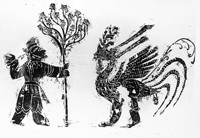1) carnival and masks


狂欢化和面具
2) revelry
[英]['revlri] [美]['rɛvḷrɪ]


狂欢化
1.
The Revelry Color of the Qin and Han Dynasties Poetry;


先秦两汉诗歌的狂欢化色彩
2.
It shows that Mo Yan creates personalized verbal space in social space by touching the revelry phenomenon and utters the independent existing voice in the fractional world.
文章以解构莫言民间的诸多文化形态来验证莫言充分张扬民间生命精神的事实,并以"狂欢化"现象为客观载体,看其在社会文化空间中营造个人化的话语空间,在"碎片的世界"中发出独立存在的声音。
3.
According to the bakhtin’s revelry poetics theory, the Small World and Students all appear art features of the revelry poetics characteristics clearly.
按照巴赫金的狂欢化诗学理论,《小世界》与《桃李》两部小说均体现出鲜明的狂欢化诗学特征。
3) carnivalization


狂欢化
1.
Probing into the carnivalization phenomenon in "Faust" from" Walpurgis Night";


从“瓦尔普吉斯之夜”看《浮士德》中的“狂欢化”现象
2.
The humanism in Bakhtin s poem theory of carnivalization;


巴赫金狂欢化诗学理论中的人本观
4) carnival
[英]['kɑ:nɪvl] [美]['kɑrnəvḷ]


狂欢化
1.
On the Carnival Features of a Midsummer-Night s Dream;


论《仲夏夜之梦》的狂欢化特征
2.
Bakhim s carnival poetry has special position in western literature theoretical history.


狂欢化诗学在西方文论史占有特殊地位,以之参照,重读鲁迅小说《铸剑》,探讨文本的狂欢化世界,可揭示复仇与狂欢的悖论关系及对当代作家的精神影响。
3.
However,the western Hunan world,filled with turbulence,agitation and unrest,is a world of carnival embodying aesthetic values different from those of traditional pastorals.
呈现了节庆、婚嫁和丰收等富有民族特色的嬉闹杂耍的狂欢场面;建构了以生死和肉体为核心的狂欢化意象;通过回环的叙事模式、双重的叙事空间及诙谐语言和咒骂语言构筑了鲜明的狂欢式话语系统。
5) carnivalesque


狂欢化
1.
The Carnivalesque Spirit in the Great Gatsby;


论《了不起的盖茨比》的狂欢化精神
2.
This paper tries to reveal the carnivalesque features embodied in this novel.


本篇论文揭示了该小说体现的狂欢化特点,比如男主人公拉夫雷斯的“笑”与嘲讽在精神上与狂欢化的笑有相似之处。
3.
Rooted in mid-century humour culture and Rabelais practice of writing, Bakhtin s theory of carnivalesque contains rich comic aesthetics, presents lots of novel and particular ideas, catches the essence and soul of comic spirit, which enables carnivalesque to be a distinct feature of comedy, indicating a kind of comic spirit with strong sense of comedy.
巴赫金植根于中世纪诙谐文化和拉伯雷创作实践的狂欢化理论,蕴含了丰富的喜剧美学思想,提出了许多新颖独到的见解,把握住了喜剧精神的本质和精髓,使"狂欢化"成了喜剧的一大特点,体现了一种喜剧精神,具有很强的喜剧意识。
6) carnival culture


狂欢文化
1.
Based on Western carnival culture theory, this paper reveals the richness of carnival culture resource in Chinese Festival Folk-customs, and puts forward five basic principles to be followed in the exploitation and utilization: 1.
借鉴西方狂欢文化理论,揭示中国节日民俗中的狂欢文化资源的丰富性,并提出开发利用狂欢文化应当遵循市场机制和政府主导相结合、坚持全民性和自由平等、节会形态不断创新、保持真实性或真实感、兼顾新奇性与安全性等5项基本原则。
补充资料:面具
| 面具 中国戏曲演员面部的塑形化妆。又称假面、脸子。塑形化妆由脸部扩及整个头部,则称假头或套头;由头部扩及全身,则称假形或形儿。源于古代歌舞,汉代百戏、唐代钵头沿用,而傩舞傩仪最为常用,是傩戏的主要标志。
在戏曲演出中,塑形化妆主要用于装扮鬼神和动物形象,它可以弥补涂面化妆之不足,长处有二:一是可以对演员的面部、头部及全身作出夸张的雕塑性改造,使之适应于所要塑造的艺术形象;二是便于改扮,一个演员可以借助于不断更换面具兼演不同角色。缺点则是表情的固定化和在某种程度上妨碍演唱。塑形化妆在一般面具、假头、形儿之外,还有如下4种表现手法 :① 面具与涂面相结合,既保持形貌的夸张,又留出嘴部以便演唱。②把一部分假头冠盔化,称为脑,如扮青龙者,头上戴龙脑,形象生动 。③ 创造了簪形,即把形儿缩小为一个头饰,如扮演蝴蝶,头上就插个蝴蝶形的簪儿。④使面具富于变化,川剧运用得最为突出。 |
说明:补充资料仅用于学习参考,请勿用于其它任何用途。
参考词条
